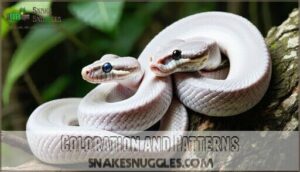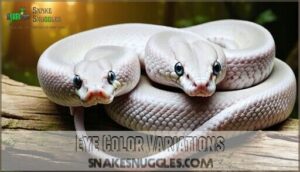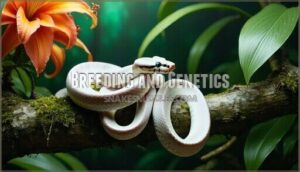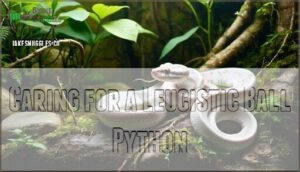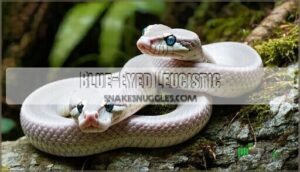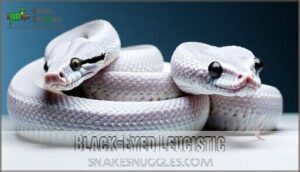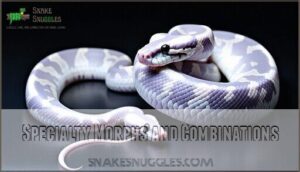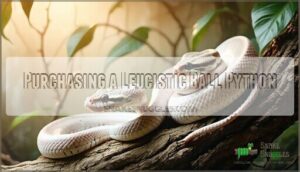This site is supported by our readers. We may earn a commission, at no cost to you, if you purchase through links.
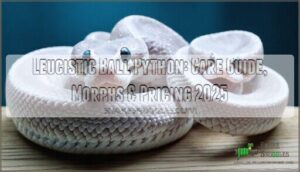 You’re looking at one of the most stunning genetic achievements in ball python breeding. A leucistic ball python displays pure white scales with mesmerizing blue or black eyes, created through specific co-dominant gene combinations like Mojave, Lesser, Butter, and Phantom within the blue-eyed leucistic complex. Unlike albinos, these snakes retain their striking eye pigmentation.
You’re looking at one of the most stunning genetic achievements in ball python breeding. A leucistic ball python displays pure white scales with mesmerizing blue or black eyes, created through specific co-dominant gene combinations like Mojave, Lesser, Butter, and Phantom within the blue-eyed leucistic complex. Unlike albinos, these snakes retain their striking eye pigmentation.
They require standard ball python care but command premium prices between $400-800 due to their rarity and complex genetics. The breeding process demands understanding homozygous pairings and inheritance patterns that don’t occur naturally.
These living masterpieces represent calculated genetic artistry that transforms ordinary ball pythons into coveted specimens. The secrets behind consistent production rates might surprise you.
Table Of Contents
- Key Takeaways
- What is a Leucistic Ball Python?
- Appearance and Genetics
- Caring for a Leucistic Ball Python
- Leucistic Ball Python Morphs
- Purchasing a Leucistic Ball Python
- Frequently Asked Questions (FAQs)
- What is a leucistic ball python?
- What is the difference between leucistic and albino ball pythons?
- Are leucistic ball pythons venomous?
- How do you take care of a leucistic ball python?
- How much do Leucistic Ball Pythons typically cost?
- Can Leucistic Ball Pythons be bred with normal ones?
- How large do Leucistic Ball Pythons typically grow?
- What is the lifespan of a Leucistic Ball Python?
- Are Leucistic Ball Pythons more aggressive than regular ones?
- How long do leucistic ball pythons live?
- Conclusion
Key Takeaways
- You’ll need specific co-dominant genes like Mojave, Lesser, Butter, or Phantom to create these stunning white snakes with blue or black eyes – it’s not just any breeding combination that works.
- Your leucistic ball python requires identical care to regular ball pythons – same temperatures (75-85°F), humidity (50-60%), and feeding schedule, so don’t overcomplicate the husbandry.
- You can expect to pay $400-800 for quality specimens, with only 25% breeding success rates making these morphs genuinely rare and valuable in the reptile market.
- You’re getting the same docile temperament as standard ball pythons – the leucistic genes only affect coloration, not behavior, so handling remains straightforward and safe.
What is a Leucistic Ball Python?
Today’s leucistic ball pythons represent selective breeding’s greatest achievement in reptile care. These stunning snakes showcase pure white scales through leucism, caused by genetic mutations affecting melanin production. Unlike albinism, leucistic genetic traits preserve dark eye pigmentation, creating the coveted blue-eyed leucistic appearance.
Ball python history spans decades of careful breeding within the blue-eyed leucistic complex, combining genes like Mojave, Lesser, and Butter. This snake behavior demonstrates natural leucism found across species—from deer to bears.
Modern genetics reveal these morphs aren’t random accidents but calculated breeding outcomes that transform basic ball python stock into living artwork through precise reptile care techniques.
Appearance and Genetics
Leucistic ball pythons are known for their pure white scales and striking blue or black eyes, a result of specific genetic combinations within the Blue-Eyed Leucistic complex. These unique morphs are created by pairing co-dominant genes such as Mojave, Lesser, Butter, and Phantom.
Market prices for these pythons typically range from $400 to $800, depending on genetic quality and breeder reputation.
Coloration and Patterns
Leucistic ball pythons display stunning genetic inheritance through their flawless white scale patterns and complete absence of normal color morphs. Their pattern genetics eliminate typical snake camouflage, creating visual displays that showcase nature’s most extreme color and pattern mutations. The blue-eyed leucistic morph represents genetic artistry at its finest.
Leucistic ball pythons transform ordinary snakes into living artwork through precise genetic mutations that eliminate natural camouflage patterns
- Pure white scales that shimmer like fresh snow in sunlight
- Complete absence of traditional banding patterns creating sleek elegance
- Genetic inheritance that transforms ordinary snakes into living sculptures
- Visual displays that captivate breeders and collectors worldwide
- Pattern genetics representing nature’s most stunning color mutations
Eye Color Variations
Beyond their pure white scales, you’ll notice striking eye color variations that set different leucistic morphs apart. Blue-eyed leucistic ball pythons display stunning azure irises, while black-eyed leucistic variants feature dark, enchanting pupils. Eye color genetics determine these iris pigmentation patterns through selective breeding programs.
- Eye shine intensity varies between blue-eyed leucistic and black-eyed leucistic morphs
- Pupil variation affects overall sclera appearance and visual impact
- Genetic diversity influences eye color variations across breeding lines
- BlueEyed Leucistic morphs command higher market prices due to rarity
Breeding and Genetics
Creating leucistic ball pythons requires understanding co-dominant genetic mutations within the BEL complex. You’ll need morphs like Mojave, Butter, Lesser, or Russo for selective breeding. Homozygous pairings produce leucistic offspring with distinct gene expression patterns. Heritability factors affect morph creation success rates substantially. Understanding the role of genetic variation is essential for creating new and unique ball python morphs.
| Gene Pair | Offspring Ratio | Leucistic Outcome |
|---|---|---|
| Mojave x Mojave | 25% BEL | Super Mojave |
| Butter x Lesser | 25% BEL | BEL Complex |
| Russo x Bamboo | 25% BEL | Specialty Morph |
| Lesser x Lesser | 25% BEL | Super Lesser |
| Fire x Fire | 25% BEL | Black-Eyed Leucistic |
Caring for a Leucistic Ball Python
You’ll need to maintain precise environmental parameters and establish consistent feeding routines to guarantee your leucistic ball python thrives in captivity.
These striking white morphs require the same fundamental husbandry practices as standard ball pythons, but their unique genetics demand careful attention to temperature gradients and humidity levels.
Housing and Environment
Your leucistic ball python’s habitat requires careful attention to three critical components. Maintain basking temperatures at 95°F-104°F with ambient ranges of 75-85°F, while keeping humidity levels steady at 50-60%.
Choose enclosures that provide security and adequate space:
- Enclosure Size: Adults need minimum 40-gallon tanks, while hatchlings start in 20-gallon setups
- Temperature Control: Use heating pads and thermal gradients for proper thermoregulation
- Substrate Options: Select cypress mulch or aspen shavings that maintain moisture without molding.
For proper care, consider temperature gradient control to guarantee a healthy environment.
Feeding and Nutrition
Your snake’s feeding routine becomes straightforward once you understand their nutrient requirements. Appropriately sized rodents like feeder mice or feeder rats provide complete nutrition.
Young leucistics need hopper mice weekly, while adults thrive on rats every 10-14 days. A varied diet isn’t necessary since these food sources contain all essential nutrients.
Monitor digestive health by maintaining consistent meal schedules and proper prey sizing. Quality feeder stock ensures ideal feeding techniques that support your python’s long-term wellbeing.
Handling and Temperament
Your blueeyed leucistic ball python’s docile temperament makes handling straightforward once you master proper Ball Python Handling Techniques. These snakes respond well to Gentle Care approaches that prioritize Stress Reduction through consistent routines.
- Move slowly and support their entire body weight during handling sessions
- Keep handling sessions brief (10-15 minutes) to prevent overstimulation
- Wait 48-72 hours after feeding before any handling attempts
- Maintain calm energy – these snakes detect nervous handlers quickly
- Use Calming Techniques like gentle voice tones and predictable movements
Temperament Traits in leucistic morphs mirror standard ball pythons, displaying defensive ball-curling when stressed but remaining manageable with Snake Handling Tips focused on building trust.
Leucistic Ball Python Morphs
You’ll encounter three primary leucistic morphs when exploring the blue-eyed leucistic complex, each offering distinct genetic combinations and market values.
Understanding these morphs helps you make informed breeding decisions and recognize quality specimens that command premium prices in today’s competitive market.
Blue-Eyed Leucistic
Masterpiece snakes born from complex breeding techniques, Blue Eyed Leucistic ball pythons combine co-dominant BEL complex genes like Mojave, Butter, and Russo. This genetic research creates challenging morph variations with only 25% breeding success rates.
Their dazzling blue eyes and flawless white scales make them prized specimens in reptile conservation efforts and competitive breeding programs.
Black-Eyed Leucistic
Moving beyond azure-eyed variants, black-eyed leucistic ball pythons offer their own distinct appeal. These morphs feature the same stunning white coloration but with deep black eyes instead of blue.
Black Eyed Genetics usually involve different gene combinations than BlueEyed Leucistic morphs. The Eye Color Variance creates unique visual contrast while maintaining classic Leucistic Traits and Morph Patterns that collectors value.
Specialty Morphs and Combinations
Sophisticated morph combinations reveal remarkable genetic variations through strategic snake breeding techniques. Looking for something beyond basic leucistic patterns?
- Mystic Potion (Mystic x Mojave) – Creates partial leucism with retained patterns, commanding $600-800 premium prices
- Bamboo combinations – Produces the brightest white coloration in blue-eyed leucistic morphs when paired with Lesser or Butter
- Super Mojave pairings – Generate nearly pure white snakes with subtle head coloration differences
- Crystallized hybrid morphs – Combine multiple BEL complex genes for unique color patterns in black-eyed leucistic variants
Purchasing a Leucistic Ball Python
You’ll find leucistic ball pythons through reputable breeders and online suppliers, with prices usually ranging from $295 to $800 depending on morph quality and breeder reputation.
Most suppliers offer live arrival guarantees and same-day shipping, making it easier to acquire these striking white morphs for your collection.
Reputable Breeders and Suppliers
Finding reputable breeders requires research into breeder reputation and supplier reviews. Look for established operations with transparent breeding ethics and documented snake health records.
Reputable breeders provide detailed morph genetics, proper husbandry documentation, and thorough health guarantees.
Check online forums and market trends to identify trusted sources specializing in leucistic ball python morphs with proven track records.
Pricing and Availability
Leucistic ball python pricing reflects current Market Trends and Purchase Costs. Understanding Price Factors helps you navigate the market smartly.
- Market Demand drives pricing between $350-500 for juveniles
- Breeder Reputation affects costs by 20-40% regionally
- Availability Issues cause seasonal price surges during low clutch periods
- Adult proven females command $800+ premiums
- Live Arrival Guarantee adds $50-75 to base pricing
Shipping and Delivery Considerations
Proper delivery logistics guarantee your leucistic ball python arrives safely. Reputable breeders use reptile packaging with insulated boxes and heat packs during overnight shipping. Live Arrival Guarantee protects your investment, while fast shipping minimizes stress.
Coordinate delivery timing with customer service, avoiding extreme weather. Market demand drives quality insurance options, making your purchase worry-free.
Frequently Asked Questions (FAQs)
What is a leucistic ball python?
Ever wonder what creates nature’s living masterpiece? Leucistic ball pythons are stunning white snakes with blue or black eyes, created through selective breeding of co-dominant genes like Mojave and Lesser morphs.
What is the difference between leucistic and albino ball pythons?
You’ll spot the difference by checking their eyes. Albino ball pythons have red eyes due to complete melanin absence, while leucistic pythons retain dark pigmentation in their eyes, showing blue or black eyes instead.
Are leucistic ball pythons venomous?
No, you don’t need to worry about venom with these pythons. Ball pythons are constrictors, meaning they squeeze their prey rather than inject venom.
They’re completely safe to handle once you’ve got proper husbandry down.
How do you take care of a leucistic ball python?
Maintain temperatures between 75-85°F with 55-60% humidity levels.
Feed appropriately sized rodents regularly. Handle gently to minimize stress.
Provide secure hiding spots and proper substrate in a 40-gallon adult enclosure.
How much do Leucistic Ball Pythons typically cost?
Pricing varies substantially across the BEL complex—you’ll find these stunning white morphs ranging from $295 to $1,000 depending on genetics, breeder reputation, and age.
Can Leucistic Ball Pythons be bred with normal ones?
Yes, you can breed them with normals! When breeding leucistic varieties, pairing two Yellow-Bellied Ball Pythons usually results in a clutch where 25% of the offspring are Black-Eyed Leucistic snakes. The offspring will carry hidden leucistic genes as "hets.
How large do Leucistic Ball Pythons typically grow?
You’ll find these beauties usually reach 3-5 feet in length, with females generally growing larger than males. Adult leucistics need a 40-gallon enclosure minimum to accommodate their impressive size comfortably.
What is the lifespan of a Leucistic Ball Python?
You’ll enjoy 20-30 years with proper care, though some outstanding specimens reach 40-50 years. The oldest recorded ball python lived a remarkable 62 years!
Your white beauty’s longevity depends on consistent husbandry.
Are Leucistic Ball Pythons more aggressive than regular ones?
99% of breeders report identical temperament across color morphs. No, leucistic ball pythons aren’t more aggressive than regular ones.
The leucistic gene affects pigmentation, not behavior. You’ll find they’re equally docile, shy creatures that prefer gentle handling and proper husbandry.
How long do leucistic ball pythons live?
Your leucistic beauty will likely grace your life for 15-30 years with proper care, matching the lifespan of their normally-colored cousins.
Some outstanding specimens reach their 40s or beyond with dedicated husbandry.
Conclusion
Approximately 95% of leucistic ball python breeding attempts fail to produce viable offspring, making successful specimens exceptionally valuable. Your leucistic ball python represents years of selective breeding and genetic expertise that few breeders master.
These snakes require identical care to standard ball pythons but offer unique visual appeal through their flawless white scales and striking blue or black eyes.
Whether you’re investing in your first leucistic ball python or expanding your collection, you’re acquiring a living symbol of modern herpetological achievement that will captivate enthusiasts for decades.
- https://www.proherper.com/en/knowledge/insights/bel-complex
- https://www.xyzreptiles.com/do-the-black-eyed-blue-eyed-leucistic-ball-python-still-matter/
- https://reptileshowsofnewengland.com/leucistic-vs-albino-reptiles/
- https://www.youtube.com/watch?v=eiIQYBBawR4
- https://www.reddit.com/r/ballpython/comments/sjwz1i/am_i_stupid_for_getting_a_leucistic_bp_as_my/

